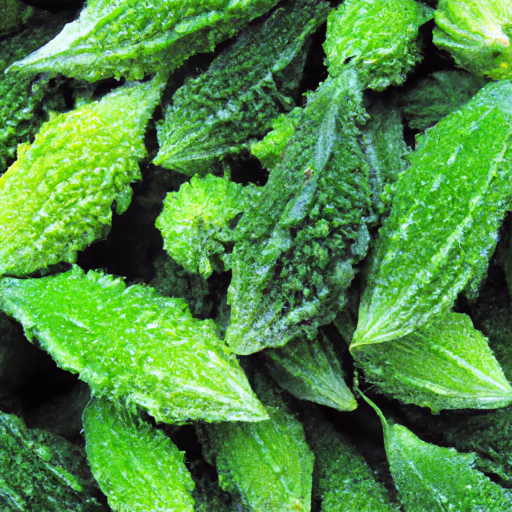Discover the Delightful Balsam Pear: A Unique Ingredient with Incredible Taste and Nutritional Value
If you’re an adventurous foodie always on the lookout for exciting ingredients to elevate your culinary creations, then the balsam pear should definitely be on your radar! Also known as bitter melon or bitter gourd, the balsam pear is a fascinating vegetable that brings a unique taste and nutritional punch to your dishes. In this blog post, we’ll delve into the wonderful world of the balsam pear and explore its taste, common uses in cooking, nutritional value, as well as some intriguing history and facts.
A Taste Sensation Like No Other
Don’t let the name fool you – while the balsam pear might be known for its bitterness, it offers a complexity of flavors that can be a pleasant surprise for your taste buds. The bitterness is perfectly balanced with subtle sweet, earthy, and slightly spicy notes. This vegetable provides a truly unique and tantalizing taste experience that can be addictive once you acquire the taste for it.
Versatile in the Kitchen
Balsam pears are a staple in many Asian cuisines, particularly in dishes originating from India, China, and Southeast Asia. Their distinctive flavor and texture make them ideal for stir-fries, curries, soups, and even pickles. Here are some popular ways to incorporate this intriguing ingredient into your cooking repertoire:
- Stir-Fries: Slice the balsam pear thinly and stir-fry it with other vegetables and your choice of protein for a flavorful and nutritious meal.
- Curries: Add balsam pear to your favorite curry recipes for a unique twist. Its flavor complements rich and spicy curry dishes beautifully.
- Soups: Balsam pear can be the star of the show in a comforting soup. Its slightly bitter taste adds depth to the broth, creating a satisfying flavor profile.
- Pickles: Take advantage of the balsam pear’s natural bitterness by transforming it into delicious pickles. The pickling process softens its bitterness and adds a tangy zing.
Nutritional Value for a Healthier You
Not only does the balsam pear bring a one-of-a-kind taste to your table, but it also offers a range of health benefits. Packed with essential nutrients, this vegetable is low in calories and high in fiber, making it a great addition to a balanced diet. Here are some key nutritional highlights:
- Vitamins and Minerals: Balsam pear is a rich source of vitamins C and A, as well as iron and potassium.
- Antioxidants: The balsam pear is loaded with antioxidants that can help protect against oxidative stress and inflammation in the body.
- Blood Sugar Regulation: Some studies suggest that compounds found in balsam pear may have a positive impact on blood sugar levels, making it potentially beneficial for individuals with diabetes.
- Digestive Health: The high fiber content of balsam pear supports healthy digestion and can aid in maintaining a healthy weight.
History and Fascinating Facts
The balsam pear has a long and fascinating history, with its origins dating back thousands of years. It is believed to have originated in the Indian subcontinent and then spread across Asia, Africa, and the Caribbean. Over time, it has become an integral part of the local cuisines in these regions.
Here are a few interesting facts about the balsam pear:
- The name “balsam pear” refers to the exploration of the melon’s medicinal properties, as it was traditionally used to treat various ailments.
- Its unique bitter taste is often an acquired taste, leading to its classification as an acquired taste food.
- The balsam pear is not only known for its culinary uses but has also found a place in traditional medicine due to its potential health benefits.
Get Adventurous with Balsam Pear
If you’re ready to embark on a culinary adventure, the balsam pear is a fantastic ingredient to explore. Its intriguing taste, diverse uses in cooking, and impressive nutritional profile make it a valuable addition to any kitchen. So, why not challenge your taste buds and experiment with this delightful vegetable? You might just discover a new favorite ingredient that adds a distinctive flair to your cooking repertoire.
Dive into the world of the balsam pear and let your creativity flourish in the kitchen!
Balsam-Pear
Origin: Balsam-pear, also known as bitter gourd or bitter melon, is native to tropical regions of Africa, India, and other parts of Asia. It is believed to have originated in the Indian subcontinent.
Common Uses: Balsam-pear is widely used in various cuisines around the world. The fruit is most commonly consumed when green and immature, as it becomes increasingly bitter as it ripens. It is often included in stir-fries, soups, curries, and salads. Balsam-pear is also used in traditional medicinal practices in some cultures.
Nutritional Benefits: Balsam-pear is low in calories and a good source of dietary fiber. It is rich in vitamin C, vitamin A, and various minerals such as potassium and magnesium. Balsam-pear also contains phytochemicals, including flavonoids and antioxidants, which are believed to have potential health benefits.
Unique Properties: One of the distinctive characteristics of balsam-pear is its bitter taste, which varies in intensity depending on the maturity of the fruit. Additionally, the fruit has a rough, warty skin and a hollow, seed-filled center. The seeds and flesh of the mature fruit are bitter, while the younger fruits are milder in flavor.
Historical Significance: Balsam-pear has a long history of use in traditional medicine for various purposes, such as maintaining blood sugar levels and promoting digestion. It has been an integral part of traditional Ayurvedic and Chinese medicine for centuries, and its use dates back to ancient civilizations. The fruit’s unique properties and potential health benefits have contributed to its long-standing cultural significance.




Use the share button below if you liked it.
It makes me smile, when I see it.